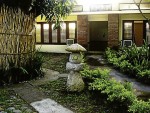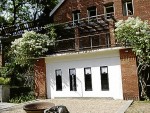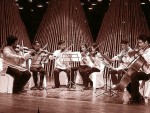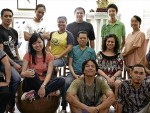Philippine Daily Inquirer
 Between the mountains and the sea, in a mango orchard in the still idyllic town of San Antonio, Zambales, stands the chateau-like Casa San Miguel, a haven for the arts owned by the Bolipata family of musical fame. (On the maternal side, the grandfather of the Bolipata musicians was Ramon L. Corpus, a noted prewar composer and violinist.)
Between the mountains and the sea, in a mango orchard in the still idyllic town of San Antonio, Zambales, stands the chateau-like Casa San Miguel, a haven for the arts owned by the Bolipata family of musical fame. (On the maternal side, the grandfather of the Bolipata musicians was Ramon L. Corpus, a noted prewar composer and violinist.)Off and on throughout the year, and especially during weekends, Casa San Miguel is a beehive of activity: Performances, exhibits, day tours, summer camp and, above all, workshops on the seven lively arts (make that more than seven): Music, literature (creative writing), visual arts, theater, films, and photography.

The center’s main activity was the recently-concluded, five-month Pundaquit Festival of the Arts, which started way back in 1993. Casa executive director is acclaimed violinist Alfonso (Coke) C. Bolipata, on whose shoulders lies the task of raising funds for the center’s many programs.
“We started 18 years ago with a budget of only P1.2 million a year,” recalls Bolipata. “This came mostly from our family’s income. We only had 12 students in music and ten in the visual arts … it was manageable then … but we have been growing. And now our students number 142.”
And the budget increased to close to P3.5 million this year.
 The turning point, as Bolipata put it, was an article about the center in a glossy magazine with a reportedly high-end readership: “We were noticed by some organizations and we received our money for last year.”
The turning point, as Bolipata put it, was an article about the center in a glossy magazine with a reportedly high-end readership: “We were noticed by some organizations and we received our money for last year.”“We have a few corporate sponsors,” he shares. “Our biggest sponsor is Starbucks, which has been with us for the last seven years. It has sustained us; it is our bread and butter.”
Most of the young musicians and other artists are scholars from low-income areas in the province: Gifted children of farmers, carpenters, fisherfolk, tricycle drivers and sari-sari store owners.
“Seventy percent are from our barangay of San Miguel,” says the violinist-administrator. “Twenty percent are from San Antonio and environs. The rest are from Olangapo, Castillejos and farther down …”

Then there are paying students (about 10 percent) from middle-and upper-income homes in Manila (tuition fee about P10,000 a year). “The payback is great for those who can afford it,” enthuses Bolipata. “They get noticed, they perform, they win awards, they get to travel abroad, they’ve been to Indonesia …”
There are also personal donors who give from P10,000 to P50,000, and the corporate sponsors with a corporate social responsibility budget. The center, however, cannot rely on dole-outs alone, and so the stately manor has been transformed into a bed-and-breakfast inn.
 “We are making money out of this which funds our scholarships,” Bolipata says. Even better sources of income are the workshops. This year there will be chamber music wokshops, bringing in a string quartet from New York; and students from Singapore, Malaysia, Hong Kong have been invited.
“We are making money out of this which funds our scholarships,” Bolipata says. Even better sources of income are the workshops. This year there will be chamber music wokshops, bringing in a string quartet from New York; and students from Singapore, Malaysia, Hong Kong have been invited.For film buffs, a more exciting event will be an indie film workshop to be handled by film greats like Brillante Mendoza, Lab Diaz, Raymond Red and Kidlat Tahimik.
“I also teach, of course,” says the violinist casually. “But all the money goes to the Casa. All the money I earn goes to the Casa.”
So the rewards here are hardly financial. You might say these are on the spiritual side, no doubt a sense of fulfillment in helping young artists grow. They may not necessarily become professionals but being talented in the arts will hopefully make them better persons, or help them in one way or another in the future.
No comments:
Post a Comment